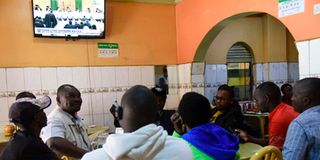People want to see with own eyes how apex court will decide presidency case

Kenyans watching the presidential election petition hearing on TV. Cameras gave members of the public who could not access the courtroom the opportunity to watch the proceedings from the comfort of their homes as if from the front row.
During the Raila versus Ruto pre-trial conference on Tuesday, Chief Justice Martha Koome thanked the media for coming to cover the case live. She said livestreaming the proceedings would assist Kenyans and other people all over the world to watch and follow the presidential election dispute.
The four-day proceedings were streamed live by NTV and other television stations. By thanking the media, Justice Koome, who is also the president of the Supreme Court, showed that she is acutely aware that live coverage gives assurance of judicial transparency. And for the important hearing, such as deciding on the presidency of this country, live coverage gives assurance of fairness.
Cameras gave members of the public who could not access the courtroom the opportunity to watch the proceedings from the comfort of their homes as if from the front row. The wall-to-wall live coverage also enhanced public understanding of how the Supreme Court works. The Supreme Court was, in turn, seen as providing open justice.
Connect with the proceedings
The cameras enabled the public to connect with the proceedings and the court players in a way that could not be achieved by journalists merely reporting on the proceedings.
No journalist could have portrayed advocate Willis Otieno’s performance on Wednesday better than the cameras. His rendering of the nursery rhyme Inky Pinky Ponky—which he sang to describe how IEBC chairman Wafula Chebukati played “childish games” in the way he announced the presidential election results—had to be seen to be believed. His animated face, exuding sweat, told a story of a thousand words that a journalist could not reproduce. No journalist could capture as vividly Pheroze Nowrejee’s impassioned plea to find Chebukati “no longer fit to hold public office” as the live coverage did. No journalist could capture Julie Soweto’s cool delivery.
Search for justice
Live coverage enabled us to see and hear with our own eyes and ears the court proceedings as they unfolded. We saw how the search for justice was being conducted.
Without it, we would have been at the mercy of media houses and their journalists to tell us what happened in the courtroom and how fair and transparent the proceedings were.
Seeing is believing. We trust more what we see for ourselves. And the cameras made that possible. Cameras in the courtroom also help the courts to demonstrate their judicial independence. Because of the open justice system, judges can act in accordance with the law without fear of outside interference.
Without the transparency, judges would attract opportunities for bribery and undue influence. Live coverage of court proceedings enhances transparency and accountability. That is why the media is a key player in promoting open justice, enhancing democracy.
Open court
Open justice requires that not only are court proceedings conducted in the open court but that the public also see and hear the proceedings. This civic participation and public accountability is critical to judicial transparency and delivery of justice.
Kenya is a leader among developing countries that allow live coverage of judicial proceedings. India’s Supreme Court allowed cameras in its proceedings in September 2018—long after Kenya. The short list of countries that allow cameras in courtrooms include South Africa, UK, Canada, Australia, New Zealand, Brazil, Germany and China.
The US Supreme Court does not permit video recording or photography of its proceedings. The Judicial Conference of the United States, which establishes policy for the federal courts, prohibits TV and radio broadcasting from its court. It argues that the Supreme Court needs to preserve its tradition and live coverage would diminish its dignity.
In any case, it further argues, the public will not understand the function of oral arguments and cameras would encourage showboating among the lawyers. It adds that cameras would distract trial participants, thus unfairly affecting the outcome of trials. The prohibition has been a subject of much debate in America. The court, however, makes radio transcripts of oral arguments and opinions and makes them available to the public.
The Public Editor is an independent news ombudsman who handles readers’ complaints on editorial matters including accuracy and journalistic standards. Email: [email protected]. Call or text 0721989264





